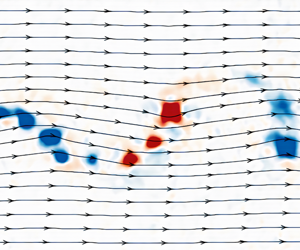Article contents
Coherence of unsteady wake of periodically plunging airfoil
Published online by Cambridge University Press: 14 March 2022
Abstract

We present an experimental investigation of the flow structure in the near wake of a NACA0012 airfoil plunging sinusoidally at a chord Reynolds number of Re = 20 000 and for a wide range of reduced frequency k and Strouhal number based on peak-to-peak amplitude St. Estimated mean thrust coefficients using the mean and fluctuating velocity fields confirm the St2 dependence as well as a significant effect of the reduced frequency for k ≤ 1. Generally, time-averaged flow quantities are better correlated with St than k in the range tested (k ≤ 3.14 and St ≤ 0.24). Analysis of the streamwise flow and cross-flow in the near wake using two-point cross-correlations and proper orthogonal decomposition reveals that the unsteady characteristics are even better correlated with St than the mean flow quantities. The percentage energy of the fundamental wake modes of the streamwise flow and the flapping mode of the cross-flow increases with increasing St, but at different rates in the drag-producing and thrust-producing wakes. There are similarities to the wake synchronisation behind oscillating bodies. The spanwise-averaged cross-correlation coefficient in the measurement domain grows linearly for small St (in drag-producing wakes), and is nearly constant at a high value for larger St (in thrust-producing wakes). Results show that the Strouhal number is the most important parameter that determines the degree of two-dimensionality of the wake, and suggest that spanwise vortices are quasi-two-dimensional for St ≥ 0.05 and x/c ≤ 4. The implications for experimental gust generators using oscillating airfoils are discussed.
JFM classification
Information
- Type
- JFM Papers
- Information
- Copyright
- © The Author(s), 2022. Published by Cambridge University Press
References
- 18
- Cited by


